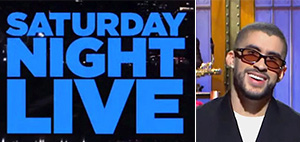The Night a Bad Bunny and A Rolling Stone Spoke to America “En Español”
October 28, 2023

By Gene Bryan / HispanicAd
Last Saturday, October 21, was an historic moment for American television. It was also a breakthrough moment for the country’s Hispanic community, Latino culture and, as such, our Hispanic communications industry. It was one of those cherished evenings where we received one of the most meaningful nods of validation, this time from America’s historically iconic comedy show: Sábado Gigante…I mean NBC’s Saturday Night Live.
Bad Bunny Monologue – SNL
By leveraging the presence of global phenomenon that is Bad Bunny — heavily announced to be both the MC and the musical star of the evening — SNL clearly signaled an indication of what to expect from this particular episode of SNL, as far as language. Why? Because everyone knows Bad Bunny stays true to himself, his language and his culture, as demonstrated in multiple mainstream TV appearances to date. In doing so, the producers were quite daring and took a very calculated risk by going beyond trying to recognize the undeniable Latino presence and voice in America. They took the extraordinary step of writing a show that didn’t stop at peppering Spanish words here and there – and with Bad Bunny performing in his seemingly unyielding Spanish. Rather, they intentionally took the bold step of producing a show that was essentially bilingual, and with skits that were predominantly in Spanish. The stories were steeped in Latino insights and cultural truths that – much like My Big Fat Greek Wedding and Crazy Rich Asians – struck a powerful and hysterically funny chord with SNL’s Latino audience while resonating and being appreciated by everyone else. Can we talk about the Royal Dansk cookie tin, which, in every Latino household, becomes storage for sewing supplies? Utter brilliance!
The result: the episode was one of the funniest shows in recent time, making it no less than the first top-rated show in the history of English-language American television to be practically in Spanish! If the legendary Executive Producer Lorne Michaels has always been recognized as a cultural visionary and precursor of trends, last week’s SNL “En Español” deserves a place in American history as a second Ricky Martin moment (circa 1999), this time on steroids.
Protective Mom 2 – SNL
It was a unique tribute to Spanish and Spanglish and not only a “wink” to 65 million U. S. Latinos but a cultural prophecy in the making to be digested, studied and implemented by Corporate America.
In more ways than one can count, it certainly paid off for NBC, Michaels and SNL as it served as a shrewd renewal exercise for the show in its new season. As savvy brands look at trends and brainstorm to chart their future, here was the nation’s hippest show proving everyone how to do it right.
Telenovela – SNL
In a recent piece by Louis Maldonado, of d expósito & Partners, published by the ANA and reproduced by HispanicAd.com, “The Spanish language serves as a way for most Latinos to live out and preserve their culture and heritage on a daily basis. Speaking Spanish helps Latinos connect with their roots and each other, creating a sense of belonging to the broader group and to our ancestral homelands. This is why, despite the faulty common narrative, an increasing number of younger Latinos are choosing to reclaim the Spanish language commit, maintain its use and/or commit to learning it better; and doing so unapologetically.” Other industry leaders, like AIMM’s Carlos Santiago, agree with Maldonado, who recently said, “While past Hispanic generations often focused on assimilation with the general population, as the Gen Z Hispanic adult population grows, a dominant trend is emerging: Hispanic Gen Z are becoming more comfortable reclaiming their heritage and engaging with Spanish and Bilingual content.”
Born in Puerto Rico, Benito Antonio Martínez Ocasio is barely 29 years old. More than achieving mainstream popularity with his reggaeton, rap, trap music in Spanish, he has shown the world the future of multiculturalism where, in the case of his unique urban sound, it intersects with rock, punk and soul and countless other influences. But, call him Bad Bunny or Benito, he was not alone. SNL engaged mega star Mick Jagger— of Rolling Stones’ fame, do you know him? — to join Bad Bunny in one of the show’s Spanish skits, aided by brilliant cast-member Marcello Hernández, the Miami-born-of-Cuban-background comedian, and guest star Chilean-American actor Pedro Pascal, for a show that wasted no opportunity to exhibit its SE HABLA ESPAÑOL vibe, including the hugely famous Lady Gaga who used Spanish to introduce one of the performances by Bad Bunny.
Where is the U. S. Hispanic Market at this point, after such compelling example of its power as this SNL episode shows? One would hope – and I would encourage – all brands to see this as a watershed moment; one that puts to an end any doubt that culture and language are paramount for connecting with Latinos. More importantly, this serves as proof that, while there will always be those that may not fully appreciate this heavily in-culture approach, the large majority of Americans are ready for it, embrace it and appreciate the freshness it brings to modern, 21st century content.




























